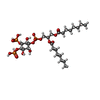+ データを開く
データを開く
- 基本情報
基本情報
| 登録情報 | データベース: PDB / ID: 6up7 | ||||||
|---|---|---|---|---|---|---|---|
| タイトル | neurotensin receptor and arrestin2 complex | ||||||
 要素 要素 |
| ||||||
 キーワード キーワード | MEMBRANE PROTEIN / GPCR signaling | ||||||
| 機能・相同性 |  機能・相同性情報 機能・相同性情報neuropeptide receptor binding / G protein-coupled neurotensin receptor activity / inositol phosphate catabolic process / symmetric synapse / angiotensin receptor binding / D-aspartate import across plasma membrane / positive regulation of gamma-aminobutyric acid secretion / TGFBR3 regulates TGF-beta signaling / Activation of SMO / regulation of membrane depolarization ...neuropeptide receptor binding / G protein-coupled neurotensin receptor activity / inositol phosphate catabolic process / symmetric synapse / angiotensin receptor binding / D-aspartate import across plasma membrane / positive regulation of gamma-aminobutyric acid secretion / TGFBR3 regulates TGF-beta signaling / Activation of SMO / regulation of membrane depolarization / positive regulation of arachidonate secretion / negative regulation of interleukin-8 production / L-glutamate import across plasma membrane / regulation of respiratory gaseous exchange / neuropeptide hormone activity / positive regulation of inhibitory postsynaptic potential / G protein-coupled receptor internalization / arrestin family protein binding / negative regulation of systemic arterial blood pressure / negative regulation of release of sequestered calcium ion into cytosol / positive regulation of glutamate secretion / Lysosome Vesicle Biogenesis / negative regulation of NF-kappaB transcription factor activity / temperature homeostasis / positive regulation of inositol phosphate biosynthetic process / response to lipid / positive regulation of cardiac muscle hypertrophy / stress fiber assembly / Golgi Associated Vesicle Biogenesis / positive regulation of Rho protein signal transduction / pseudopodium / detection of temperature stimulus involved in sensory perception of pain / negative regulation of interleukin-6 production / positive regulation of receptor internalization / negative regulation of Notch signaling pathway / enzyme inhibitor activity / neuropeptide signaling pathway / transport vesicle / insulin-like growth factor receptor binding / clathrin-coated pit / axon terminus / negative regulation of protein ubiquitination / GTPase activator activity / cytoplasmic vesicle membrane / Activated NOTCH1 Transmits Signal to the Nucleus / Peptide ligand-binding receptors / positive regulation of release of sequestered calcium ion into cytosol / blood vessel diameter maintenance / dendritic shaft / adult locomotory behavior / learning / G protein-coupled receptor binding / Signaling by high-kinase activity BRAF mutants / G protein-coupled receptor activity / MAP2K and MAPK activation / cytoplasmic side of plasma membrane / positive regulation of protein phosphorylation / terminal bouton / Signaling by RAF1 mutants / Signaling by moderate kinase activity BRAF mutants / Paradoxical activation of RAF signaling by kinase inactive BRAF / Signaling downstream of RAS mutants / endocytic vesicle membrane / Signaling by BRAF and RAF1 fusions / Cargo recognition for clathrin-mediated endocytosis / protein transport / Thrombin signalling through proteinase activated receptors (PARs) / Clathrin-mediated endocytosis / cytoplasmic vesicle / ubiquitin-dependent protein catabolic process / perikaryon / G alpha (s) signalling events / G alpha (q) signalling events / molecular adaptor activity / chemical synaptic transmission / dendritic spine / proteasome-mediated ubiquitin-dependent protein catabolic process / transcription coactivator activity / positive regulation of ERK1 and ERK2 cascade / positive regulation of phosphatidylinositol 3-kinase/protein kinase B signal transduction / Ub-specific processing proteases / protein ubiquitination / nuclear body / positive regulation of apoptotic process / G protein-coupled receptor signaling pathway / membrane raft / receptor ligand activity / Golgi membrane / negative regulation of gene expression / lysosomal membrane / intracellular membrane-bounded organelle / ubiquitin protein ligase binding / positive regulation of gene expression / regulation of transcription by RNA polymerase II / negative regulation of apoptotic process / chromatin / protein-containing complex binding / cell surface / endoplasmic reticulum / Golgi apparatus 類似検索 - 分子機能 | ||||||
| 生物種 |  Homo sapiens (ヒト) Homo sapiens (ヒト) | ||||||
| 手法 | 電子顕微鏡法 / 単粒子再構成法 / クライオ電子顕微鏡法 / 解像度: 4.2 Å | ||||||
 データ登録者 データ登録者 | Qu, Q.H. / Huang, W. / Masureel, M. / Janetzko, J. / Kobilka, B.K. / Skiniotis, G. | ||||||
 引用 引用 |  ジャーナル: Nature / 年: 2020 ジャーナル: Nature / 年: 2020タイトル: Structure of the neurotensin receptor 1 in complex with β-arrestin 1. 著者: Weijiao Huang / Matthieu Masureel / Qianhui Qu / John Janetzko / Asuka Inoue / Hideaki E Kato / Michael J Robertson / Khanh C Nguyen / Jeffrey S Glenn / Georgios Skiniotis / Brian K Kobilka /   要旨: Arrestin proteins bind to active, phosphorylated G-protein-coupled receptors (GPCRs), thereby preventing G-protein coupling, triggering receptor internalization and affecting various downstream ...Arrestin proteins bind to active, phosphorylated G-protein-coupled receptors (GPCRs), thereby preventing G-protein coupling, triggering receptor internalization and affecting various downstream signalling pathways. Although there is a wealth of structural information detailing the interactions between GPCRs and G proteins, less is known about how arrestins engage GPCRs. Here we report a cryo-electron microscopy structure of full-length human neurotensin receptor 1 (NTSR1) in complex with truncated human β-arrestin 1 (βarr1(ΔCT)). We find that phosphorylation of NTSR1 is critical for the formation of a stable complex with βarr1(ΔCT), and identify phosphorylated sites in both the third intracellular loop and the C terminus that may promote this interaction. In addition, we observe a phosphatidylinositol-4,5-bisphosphate molecule forming a bridge between the membrane side of NTSR1 transmembrane segments 1 and 4 and the C-lobe of arrestin. Compared with a structure of a rhodopsin-arrestin-1 complex, in our structure arrestin is rotated by approximately 85° relative to the receptor. These findings highlight both conserved aspects and plasticity among arrestin-receptor interactions. | ||||||
| 履歴 |
|
- 構造の表示
構造の表示
| ムービー |
 ムービービューア ムービービューア |
|---|---|
| 構造ビューア | 分子:  Molmil Molmil Jmol/JSmol Jmol/JSmol |
- ダウンロードとリンク
ダウンロードとリンク
- ダウンロード
ダウンロード
| PDBx/mmCIF形式 |  6up7.cif.gz 6up7.cif.gz | 134.5 KB | 表示 |  PDBx/mmCIF形式 PDBx/mmCIF形式 |
|---|---|---|---|---|
| PDB形式 |  pdb6up7.ent.gz pdb6up7.ent.gz | 92.6 KB | 表示 |  PDB形式 PDB形式 |
| PDBx/mmJSON形式 |  6up7.json.gz 6up7.json.gz | ツリー表示 |  PDBx/mmJSON形式 PDBx/mmJSON形式 | |
| その他 |  その他のダウンロード その他のダウンロード |
-検証レポート
| 文書・要旨 |  6up7_validation.pdf.gz 6up7_validation.pdf.gz | 760.1 KB | 表示 |  wwPDB検証レポート wwPDB検証レポート |
|---|---|---|---|---|
| 文書・詳細版 |  6up7_full_validation.pdf.gz 6up7_full_validation.pdf.gz | 765.8 KB | 表示 | |
| XML形式データ |  6up7_validation.xml.gz 6up7_validation.xml.gz | 24.1 KB | 表示 | |
| CIF形式データ |  6up7_validation.cif.gz 6up7_validation.cif.gz | 36.1 KB | 表示 | |
| アーカイブディレクトリ |  https://data.pdbj.org/pub/pdb/validation_reports/up/6up7 https://data.pdbj.org/pub/pdb/validation_reports/up/6up7 ftp://data.pdbj.org/pub/pdb/validation_reports/up/6up7 ftp://data.pdbj.org/pub/pdb/validation_reports/up/6up7 | HTTPS FTP |
-関連構造データ
- リンク
リンク
- 集合体
集合体
| 登録構造単位 | 
|
|---|---|
| 1 |
|
- 要素
要素
| #1: タンパク質・ペプチド | 分子量: 819.007 Da / 分子数: 1 / 由来タイプ: 組換発現 / 由来: (組換発現)  Homo sapiens (ヒト) Homo sapiens (ヒト)発現宿主:  参照: UniProt: P30990*PLUS |
|---|---|
| #2: タンパク質 | 分子量: 39062.840 Da / 分子数: 1 / 由来タイプ: 組換発現 / 由来: (組換発現)  Homo sapiens (ヒト) / 遺伝子: ARRB1, ARR1 Homo sapiens (ヒト) / 遺伝子: ARRB1, ARR1発現宿主:  参照: UniProt: P49407 |
| #3: タンパク質 | 分子量: 37360.656 Da / 分子数: 1 / 由来タイプ: 組換発現 詳細: missing regions were not modeled due to local low resolution/flexibility. 由来: (組換発現)  Homo sapiens (ヒト) / 遺伝子: NTSR1, NTRR Homo sapiens (ヒト) / 遺伝子: NTSR1, NTRR発現宿主:  参照: UniProt: P30989 |
| #4: タンパク質・ペプチド | 分子量: 783.958 Da / 分子数: 1 / 由来タイプ: 組換発現 詳細: actual sequence for this poly-A exists, however, the local resolution for this region is not sufficient to register the amino acids. 由来: (組換発現)  Homo sapiens (ヒト) Homo sapiens (ヒト)発現宿主:  |
| #5: 化合物 | ChemComp-PIO / [( |
| 研究の焦点であるリガンドがあるか | Y |
| Has protein modification | Y |
-実験情報
-実験
| 実験 | 手法: 電子顕微鏡法 |
|---|---|
| EM実験 | 試料の集合状態: PARTICLE / 3次元再構成法: 単粒子再構成法 |
- 試料調製
試料調製
| 構成要素 | 名称: NTSR_Arrestin / タイプ: COMPLEX / Entity ID: #1-#4 / 由来: RECOMBINANT |
|---|---|
| 由来(天然) | 生物種:  Homo sapiens (ヒト) Homo sapiens (ヒト) |
| 由来(組換発現) | 生物種:  |
| 緩衝液 | pH: 7.4 |
| 試料 | 包埋: NO / シャドウイング: NO / 染色: NO / 凍結: YES |
| 急速凍結 | 凍結剤: ETHANE |
- 電子顕微鏡撮影
電子顕微鏡撮影
| 実験機器 |  モデル: Titan Krios / 画像提供: FEI Company |
|---|---|
| 顕微鏡 | モデル: FEI TITAN KRIOS |
| 電子銃 | 電子線源:  FIELD EMISSION GUN / 加速電圧: 300 kV / 照射モード: FLOOD BEAM FIELD EMISSION GUN / 加速電圧: 300 kV / 照射モード: FLOOD BEAM |
| 電子レンズ | モード: OTHER |
| 撮影 | 電子線照射量: 56 e/Å2 フィルム・検出器のモデル: GATAN K2 SUMMIT (4k x 4k) |
- 解析
解析
| CTF補正 | タイプ: PHASE FLIPPING AND AMPLITUDE CORRECTION |
|---|---|
| 3次元再構成 | 解像度: 4.2 Å / 解像度の算出法: FSC 0.143 CUT-OFF / 粒子像の数: 254725 / 対称性のタイプ: POINT |
 ムービー
ムービー コントローラー
コントローラー




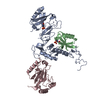
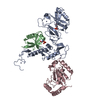
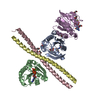

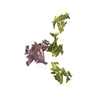
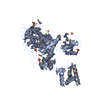
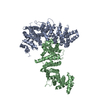
 PDBj
PDBj
















